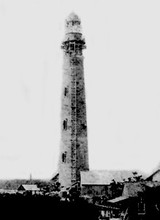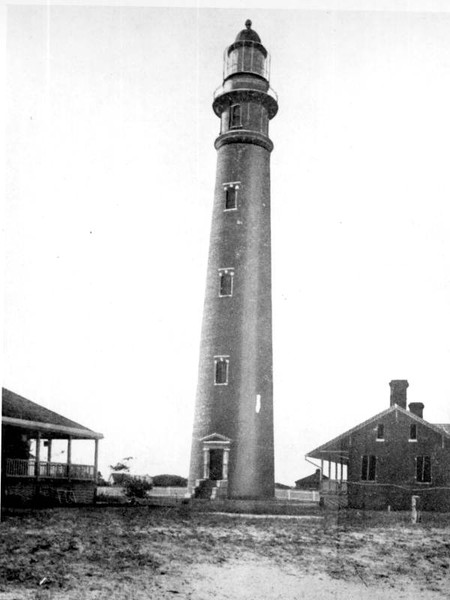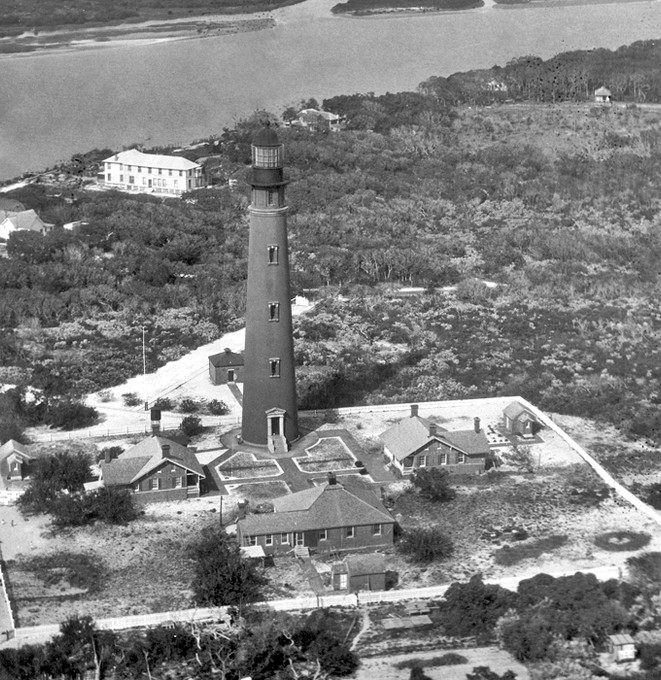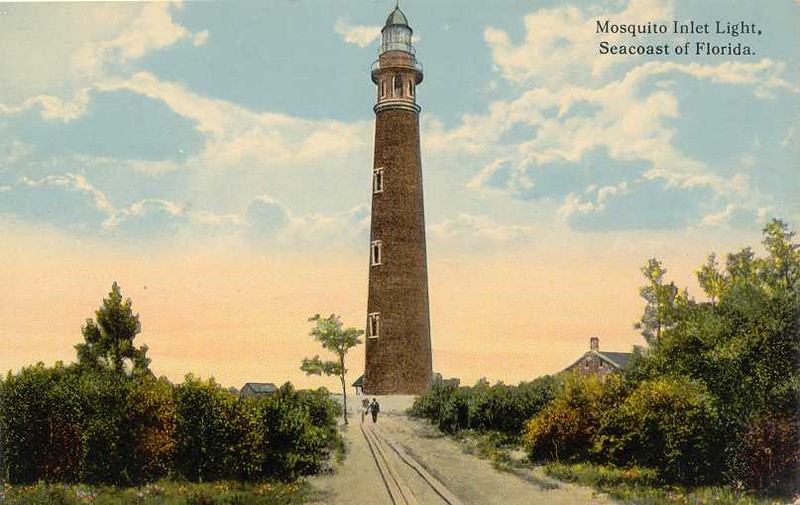Ponce de Leon Inlet Lighthouse
Introduction
Text-to-speech Audio
Images


1887

1927

1930

Postcard View

Third order revolving/flashing lens with a 500 watt electric lamp.

Backstory and Context
Text-to-speech Audio
Early History and Construction
The Ponce de Leon Inlet Lighthouse, located ten miles south of Daytona Beach, Florida, is the second tallest brick lighthouse tower in the United States; only Cape Hatteras Lighthouse is taller. A remarkably complete station, the Ponce de Leon Light Station consists of a 176-foot tall brick tower, a principal and two assistant keepers' dwellings, an oil house, a pump house, and three wood shed/privy structures.
The Ponce de Leon Inlet is located on what is often hailed as the seventh most treacherous inlet near the Atlantic Coast. The location of the Ponce Inlet Lighthouse is littered with tales of its many shipwrecks, numbering in over 70. Such as the wreck of the French naval officer and navigator Jean Ribault, whose entire fleet washed up on nearby shores during a hurricane in 1565.
The first lighthouse for what is now the Ponce de León Inlet was erected on the south side of the inlet in 1835, but, after suffering damage from storms and the Second Seminole War, the building collapsed the following year. It was not until 1883 that another effort was begun to place a light there, this time on the inlet’s north shore.
The Lighthouse Board saw that the location between St. Augustine and Cape Canaveral was clear and already had a clear history of ships crashing against it. They saw that Mosquito Inlet was a location in dire need of a lighthouse. On the date of August 7th, 1882, the Congress of the United States approved of the building of the lighthouse and appropriated thirty thousand dollars for its construction. Using the appropriated funds, the 30 acres of land for what would be the lighthouse was officially purchased on March 21, 1883.
Construction of the Lighthouse began in 1884 and was designed after the Light-House Boards standard blueprint for the time period, the completed Light House stands at 175 feet and is built from over one million bricks shipped from Maryland and New York.
The well-renowned architect, artist, and author, Francis Hopkins Smith was the one to design the tower. His construction firm would eventually go on to build the base for the Statue of Liberty in the future. According to Thomas W. Taylor, author of The Florida Lighthouse Trail, the chief engineer of construction of the lighthouse Orville E. Babcock, tried to row ashore in a schooner named Pharos to begin construction on the new lighthouse— only for the ship to flip over in the rough surf. Babcock and three others drowned. In spite of that tragedy, work shortages from a lack of funding, and mosquitos, the lighthouse was finished and lit for the very first time on November 1st, 1887. The beacon’s light could be seen 20 miles out from the ocean. It was initially fixed with a kerosene lamp and Fresnel lens, which was crafted in 1867 by Barbier et Fenestre in Paris.
In 1887, a fixed Fresnel lens was installed and showed brightly from the lighthouse. As time passed and because of vibrations from rockets launched close to the lighthouse, prisms were dropping and breaking from the lens. The Fresnel lens was repaired and restored years later and the light was electrified. This lens has 368 prisms and stands 16 feet tall and weighs 8,000 pounds. Today, the lens uses plastic prisms, instead of glass. “A collection of restored lighthouse lenses is displayed at the Ponce Inlet Light Station, including the 1860 rotating first order Fresnel lens from the Cape Canaveral Lighthouse” (Brotemarkle). Many historians say that Ponce de León himself never visited this lighthouse. But in 1897, well-known author, Stephen Crane, was shipwrecked off the coast and he and other men used the lighthouse as their guide to come to shore. “Stephen Crane commemorated the lighthouse in one of his short stories, ‘The Open Boat,’ which was one of his best sea stories” (Taylor). Stephen Crane was also known for his most popular novels, “The Red Badge of Courage.”
Fresnel Lenses
The original lens used in the Ponce inlet Lighthouse was developed by French physicist and engineer Augustin-Jean Fresnel who was determined to create a more effective way to keep seaman safe, he developed the lens to project four times the number of lenses before it. The Fresnel lens at this time could be seen over 20 kilometers off shore and is still used today, this innovation even though old fashioned kept the marina of Ponce Inlet much safer. By 1933 the Light House service came in to electrify Ponce Inlet’s Light House and ended up altering the light pattern to a more flashing beacon, an added safety feature, a newer updated rotating third Fresnel lens was put in to make the house shine eve brighter.
The Lighthouse’s First Keeper - William Rowlinski
The lighthouse’s first keeper - William Rowlinski, did the honors of lighting it for the first time. Rowlinski was a Russian emigrant born in 1833, who came to the United States from Russia, at the age of 17. Originally, he settled in Charleston, South Carolina, where and married Mary Jane Rebecca Hilton, a school teacher, in 1857. He fought in the Civil War on the side of the Confederates.
William Rowlinski and his family moved to Salters, South Carolina, in 1870, where they raised their six children. In the year of 1884, he was transferred to Cape Romain, where the South Carolina Light Station was located. Later on, in April 1887, he was selected as the first Assistant Keeper to the Romain Lighthouse. In October of 1887, he was appointed as official keeper for the Mosquito Inlet Lighthouse. The Rowlinski family lived well at Mosquito inlet Lighthouse.
However, William found it hard to cooperate with his lighthouse keeper assistants. Rowlinski was eventually transferred back to South Carolina once more, only this time to Georgetown, to work at the South Carolina Light Station. After resigning, he moved back to Florida in 1902 to live in a house nearby Mosquito Inlet and its lighthouse, where he lived until he died in May 29, 1914. Rowlinski was succeeded as the first keeper of the Mosquito Inlet Lighthouse by none other than Thomas Patrick O’Hagan, an assistant keeper on December 1, 1893.
The Next Lighthouse Keeper - Thomas O'Hagan
Over the years, many keepers and their families lived in the Ponce Inlet Lighthouse. Thomas O’Hagan was a keeper at the lighthouse from 1893-1905. The life of a lighthouse keeper and their families was not fancy. Lighthouse keepers received small salaries in the amount of $600-700 a year, which included an allowance for food. Because the salary was not enough, some keepers would get a second job to help feed their families. During 1926, families who lived on the lighthouse grounds, had running water, indoor plumbing and electricity. Things that were necessary, were more advanced than the way it was during the 1800s. “Water that was used for cooking and drinking was collected from the roof into a cistern. Before electricity, a windmill was used to bring water to the surface and a hand pump used in the kitchen is still on display in one of the houses” (Bansemer). Living at the lighthouse was somewhat dangerous because the keeper had to rescue many sailors, where their ships were wrecked. The family would have to share their home, give them clothes and feed them.
Twentieth Century
The original fixed first-order lens of the lighthouse was replaced by a revolving third-order one that used electricity as a power source in 1933. The lighthouse was transferred from the abolished Lighthouse Service to the Coast Guard in 1939, which would oversee it for the next three decades. When World War II started, the lighthouse was no longer used as a lighthouse and the keepers and their families were removed to repurpose it as a Coast Guard base to watch for enemy submarines. Several battles between the US and enemy forces took place off the coast of the lighthouse in this time period, the principal keeper at the time journaled accounts of military cargo washing ashore.
In 1952 the lighthouse was automated. Today, the lighthouse is owned by town Ponce Inlet and is preserved as one of the most complete light stations in the entire nation of the United States, having all of its original buildings still intact. In 1970, the Coast Guard abandoned the station in favor of a nearby skeletal light tower.
By 1970 a new lighthouse beacon was established on the South side of the Inlet and Ponce Inlet’s Light house became abandoned and was no longer cared for, this site had rich historical value including adjacent properties once inhabited by the Lighthouse keepers family and other staff members. Concerned about preserving such histories many people in the community came together in order to form the Ponce de Leon Inlet Lighthouse Preservation Association which focused on preservation and restoration of the beacon and its surrounding structures. The Ponce de Leon Inlet Lighthouse Preservation Association requested that the city of Ponce Inlet gain ownership of the Lighthouse from the coastguard and was successful in doing so by the year 1972.
Museum and Historic Site
In 1972 the site was listed in the National Register of Historic Places and conveyed to the Town of Ponce Inlet through the Historic Surplus Property Program. In 1982 the light was restored to active service, and in 1998 the facility was designated a National Historic Landmark. It was the first lighthouse to receive this title in Florida and it is one of the few to receive it in the country.Today the complex is open to the public, with several of the buildings used as exhibit space.
Ponce Inlet Lighthouse is now a museum was created followed by the coast guard installing a fully modern and functional beacon, restoring the lighthouse to its original glory. The Ponce de Leon Inlet Lighthouse Preservation Association was very determined to keep the Lighthouse fully historically authentic and by 2004 staff fully restored it to it’s original 1933 look including the installment of the first electric third order Fresnel lens. The restoration maintained all of the original parts of the Lighthouse, it was a fully authentic and historically intact endeavor that makes visiting it a real treat.
Each year, over 100,000 people visit Ponce de Leon Lighthouse and Museum. The lighthouse is owned by the town of Ponce Inlet and managed by the Ponce de Leon Inlet Lighthouse Preservation Association. Visitors may climb the tower on their own and visit the keeper’s quarters and other historic buildings on the property, which is now the museum. Visitors can tour the Lighthouse and Tower and can climb to the top, the Woodshed Theater that was built by the three keepers’ dwellings, the Second Assistant Keeper’s Dwelling, which shows photographs, charts, old uniforms and other artifacts. The Principal Keeper’s Dwelling displays ship models and navigation instruments. Visitors can also tour the Generator/Radio Room Building, Lens Exhibit Building, Oil Storage Building and Pump House. There is also a gift shop, where visitors can purchase souvenirs.
The lighthouse hosts every year, several fundraisers and events. They have the Echo Ranger Event, Museum at Night, Climb to the Moon, National Lighthouse Day, Biketoberfest at the Lighthouse, Veteran’s Day, Thanksgiving Gifts Event and Winter Holiday Event. Sometimes, you may see Weddings performed at the lighthouse station. Ponce de Leon Inlet Lighthouse and Museum are opened from 10 AM-9 PM during the summer and 10 AM-6 PM the rest of the year. For more information about the lighthouse, their website is ponceinlet.org.
Sources
Bansemer, Roger. Bansemer’s Book of Florida Lighthouse. Sarasota, Fla.: Pineapple Press, c1999.
Brotemarkle, Ben. “Ponce Inlet Lighthouse stands tall.” The Florida Historical Quarterly. The Florida Historical Society, 29 July 2014. Web. A27.
“History of the Ponce de Leon Inlet Light Station” Ponce Inlet Lighthouse & Museum, www.ponceinlet.org/history.cfm. Accessed 24 February 2018.
“Keeper William Rowlinski” Ponce Inlet Lighthouse & Museum, http://ponceinlet.org/keeper-william-rowlinski. Accessed 24 February 2018.
Taylor, Thomas W. The Florida Lighthouse Trail. Pineapple Press, 2001.
Timeline for Light Station History. https://www.ponceinlet.org/Timeline-for-Light-Station-History-6-94.html. Accessed 10 October 2019.
www.midwestconnection.org/Lighthouses/georgia_florida/PonceDeLeon.htm.
